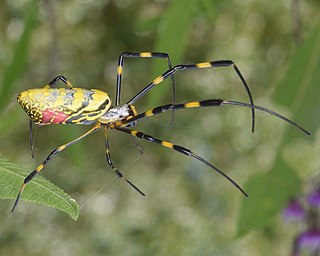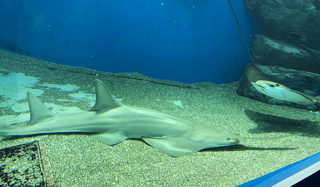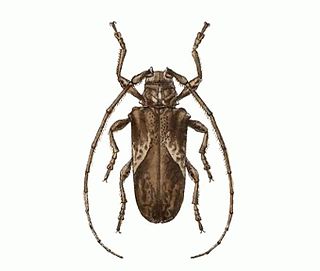Related Research Articles

Paraponera clavata, commonly known as the bullet ant, is a species of ant named for its extremely painful sting. It inhabits humid lowland rainforests in Central and South America.

Trichonephila clavata, also known as the Joro spider (ジョロウグモ , is a member of the Trichonephila genus. The spider can be found throughout Japan, Korea, Taiwan, China. Due to its large size and the bright, unique colors of the female Trichonephila, the spider is well-favored in Japan.

Poneratoxin is a paralyzing neurotoxic peptide made by the bullet ant Paraponera clavata. It prevents inactivation of voltage gated sodium channels and therefore blocks synaptic transmission in the central nervous system. Specifically, poneratoxin acts on voltage gated sodium channels in skeletal muscle fibers, causing paralysis, and nociceptive fibers, causing pain. It is rated as a 4 plus on the Schmidt sting pain index, the highest possible rating with that system, and its effects can cause waves of pain up to twelve hours after a single sting. It is additionally being studied for its uses in biological insecticides.

The dwarf sawfish or Queensland sawfish, Pristis clavata, is a sawfish of the family Pristidae, found in tropical Australia. This endangered species is the smallest species in its family.

The thornback ray, or thornback skate, is a species of ray fish in the family Rajidae.

Hakea clavata, commonly known as coastal hakea is a shrub that is endemic to an area along the south coast of Western Australia. It has thick leaves, pink and grey flowers and grows on rocky outcrops.
C. clavata may refer to:

Brownimecia is an extinct genus of ants, the only genus in the tribe Brownimeciini and subfamily Brownimeciinae of the Formicidae. Fossils of the identified species, Brownimecia clavata and Brownimecia inconspicua, are known from the Late Cretaceous of North America. The genus is one of several ants described from Late Cretaceous ambers of New Jersey. Brownimecia was initially placed in the subfamily Ponerinae, until it was transferred to its own subfamily in 2003; it can be distinguished from other ants due to its unusual sickle-like mandibles and other morphological features that makes this ant unique among the Formicidae. B. clavata is also small, measuring 3.43 millimetres (0.135 in), and a stinger is present in almost all of the specimens collected. The morphology of the mandibles suggest a high level of feeding specialization.

Paraponera is a genus of ants and the only genus in the subfamily Paraponerinae. The name means "near-Ponera".

Onciderini is a tribe of longhorn beetles of the subfamily Lamiinae, they are prevalent across Europe in nations such as Turkey, and Finland.

Paramuricea clavata, the violescent sea-whip, is a species of colonial soft coral in the family Plexauridae. It is found in shallow seas of the north-eastern Atlantic Ocean and the north-western Mediterranean Sea as well as Ionian Sea. This species was first described by the French naturalist Antoine Risso in 1826.

Ischiocentra is a genus of longhorn beetles of the subfamily Lamiinae, containing the following species:
Ischiocentra diringshofeni is a species of beetle in the family Cerambycidae. It was described by Lane in 1956. It is known from Brazil.
Ischiocentra disjuncta is a species of beetle in the family Cerambycidae. It was described by Martins and Galileo in 1990. It is known from Venezuela.
Ischiocentra hebes is a species of beetle in the family Cerambycidae. It was described by James Thomson in 1868. It is known from Brazil.
Ischiocentra monteverdensis is a species of beetle in the family Cerambycidae. It was described by Giesbert in 1984. It is known from Panama and Costa Rica.
Ischiocentra quadrisignata is a species of beetle in the family Cerambycidae. It was described by James Thomson in 1868. It is known from Brazil.
Ischiocentra stockwelli is a species of beetle in the family Cerambycidae. It was described by Giesbert in 1984. It is known from Panama and Costa Rica.

Kunzea clavata, commonly known as the Torbay spearwood, is a flowering plant in the myrtle family, Myrtaceae and is endemic to a small area on the south coast of Western Australia. It is a shrub or tree, typically with many branches and grows to a height of 2.5 to 4 metres. It blooms between September and October producing yellow flowers.

Pseudoceratina is a genus of sponge within the family Pseudoceratinidae. They are characterized by possession of a dendritic fiber skeleton lacking laminar bark but containing pith. They have been found in a variety of habitats including the Great Barrier reef, the Red Sea, and Jamaica. Sponges of this genus have a microbiome known to produce a variety of chemicals that are used in pharmaceutical and anti-fouling activities. Notably, a species in this genus produces a chemical that is effective in inhibiting the migration of metastatic breast cancer cells.
References
- ↑ BioLib.cz - Ischiocentra clavata. Retrieved on 8 September 2014.